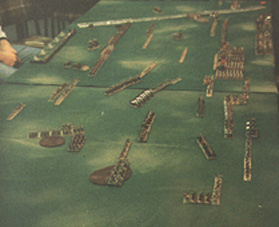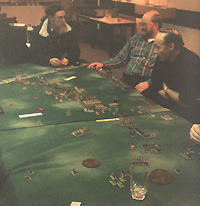
The situation after turn 2. The scythed chariots in the centre are about to hit the Roman cavalry.
This battle was refought in 1998 by members of the Christchurch Wargaming Society at the Woolston Club using DBM rules.
The scenario description, including order of battle, etc., can be found by clicking here. The battle was fought in 15mm scale, on a 10' by 4' table. We started setting-up at 12.30, kicked off at 1.00, and had finished packing up by 4.45. Not bad for over 2000 AP worth! Each side had 19 bounds.
The cast:
Seleucids:
Mendes, commander of the right vanguard: Dean Gillam
Antiochus the Great, C-in-C and commander of the right wing: Brent Burnett-Jones
Philippos, commander of the elephants and phalanx: Brian Sowman
Seleucus, commander of the left wing: Dave Evans
Zeuxis, commander of the left vanguard: Keith Adams
Romans:
Marcus Aemilius, commander of the left Allied legion and camp: Ion Dowman
Tiberius Sempronius Gracchus, commander of the left Roman legion: Paul Hutton
Lucius Cornelius Scipio, commander of the right Roman legion: Mark Otley
Gnaeus Domitius, C-in-C and commander of the right Allied legion: Corbon Loughnan
Eumenes, commander of the Pergamenes: Andre Evers (standing in for Martin Abell)
Diophanes, commander of the Achaeans: Andre Evers
Olympian Zeus: Luke Ueda-Sarson
The battle started out with the Roman players nervously looking at the huge size of the host opposite them. They took the first move and the Pergamenes and Achaeans raced forwards, and angled to their left, hoping to engage the weak Seleucid foot, while leaving the Roman Equites to deal with the scythed chariots.
These were dispatched with relatively little effort, but Seleucus was so worried about being disrupted by his own side's chariots that his horse sat still and failed to advance sufficiently for a long time.

Mendes decided to advance his Argyraspides down the centre-side of the river, rather than cross it, thus squeezing out his own C-in-C somewhat. His supporting psiloi, fighting in depth, did very well against the opposing Roman velites, and even pushed back the legions a few paces.
Diophanes' thureophoroi had meanwhile engaged the Zeuxis' levy archers that had advanced surprisingly eagerly - and despite the wet weather, the archers gave a surprisingly good account of themselves. In the centre, the phalanx inched forward, hampered by the velites of the right Roman legions.
Aided by Eumenes' xystophoroi, Diophanes' men finally routed their opponents, and a cheer went up on the Roman side as they were the first to break an enemy command. Euphoria was short-lived however, as the next bound the Argyraspids launched a devestating charge into the left Latin legion that in a series of 6-1 rolls carved their way through the legionaries. Thus the Roman left broke - although by the Argyraspids rather than to the cataphracts, who were still ominously unengaged.
Eumenes horse closely pursued the fleeing troops of Zeuxis' command, and the rout severly disrupted Seleucus' cataphracts. Confusion reigned even worse in this quarter since Diophanes' command had suffered enough casualties by this stage to become demoralized in turn, and the scattered Seleucids were being picked off one-by-one by Eumenes' men. His troops, while on paper looked unlikely to harm their opposites, had the benefit of a far lower ee to PiP ratio, and hence controlability.
Domitius' legion, taking advantage of the timidness of the phalanx, advanced boldly towards the troops 'guarding' its left flank. Superior Roman abilities, and a bit of luck, saw a single element of velites take out 6 Galation warband elements in a single bound single-hendedly from a flanking position - it later went on to take out 4 pikemen in the same fashion!
This sudden reversal panicked Seleucus' men, and deciding that discretion was the better part of valour, the rest of his command feld from the field.
Seeing the Galatians on the other side of the phalanx advancing to his front, Scipio ordered his reserve elephants forward. A few Galatians initially panicked (losing two elements), but soon realized that these beasts were not in the same league as their Seleucid rivals, and they were scarred off the field by the loud shouts of the barbarian warriors.
It was to his left however that the battle would be decided. Antiochus' cataphracts lined up squarly with Gracchus' legion - now with an open left flank, with the Argyraspids pursuing the fleeing Latins towards the Roman camp. The catafracts had the initiative, and charged in. When the dust cleared, the entire line of blades had collapsed - and the wall of steel rode on!

With three commands broken, two of which were Roman, the Romans had had enough. They had come very close however - they didn't know it at the time, but if they had broken the Seleucid cataphract charge (not so hard to do when facing factor 3 (I) with a factor 4 defence), then the Seleucids would have gone under right that bound - they were only 5 ee away from being broken.
Everyone was fairly happy with the result - and keen to have another go in fact, which I guess is the real measure of success in a game like this. This was the first time I'd organized a game as large as this. The scale is very good. A few 'quirk' results couldn't dominate the game, and at this scale, PiP dice distribution are as important as troop ratings. You'd not figure the miniscule forces of the Achaeans and Pergamenes to rout the two commands opposite them - outnumbering them 3 to 1 - with 12 Kn included, I'm glad to say that, as in the real thing, they proved up to the task.
Of course, one key to the battle was choosing the re-enactors with an eye to their historical forebears! The Seleucid phalanx didn't do much in the real battle - so I gave it to a cautious commannder... likewise Eumenes had to be someone I knew wouldn't be overly concerned about hanging flanks, but would get stuck right in - Andre usually plays Central Asian City States.
This has given me a taste for more large-scale battles - although organizing them can be hard graft - this one took me a whole week's work! I hope to do at least one in the next Nationals convention.